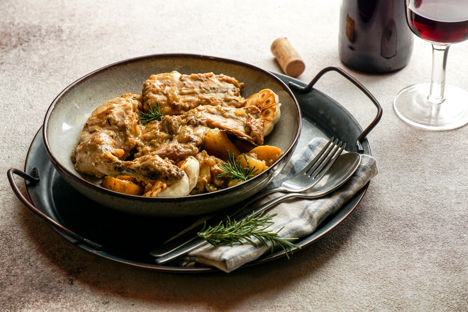
8 must-try dishes when you're in Tenerife
The biggest of the Canary Islands, Tenerife is loved by holidaymakers looking for a sunny getaway. Travel plans under way? Here are the local dishes you should order when you’re there.
8 must-try dishes when you're in Tenerife
The biggest of the Canary Islands, Tenerife is loved by holidaymakers looking for a sunny getaway. Travel plans under way? Here are the local dishes you should order when you’re there.
Tenerife is a tourism hotspot. Around five million holidaymakers travel there each year, making it not only the most visited island in the Canary Islands archipelago, but also a hugely important tourism region in Spain. Between its sandy beaches, mountainous terrain, enormously popular Carnival of Santa Cruz de Tenerife and vibrant towns, it’s easy to see why. There's also plenty for those who put eating at the top of their travel plans – Tenerife is home to everything from refined Michelin-starred kitchens to relaxed, homely guachinches, where local wines sit alongside traditional dishes that celebrate the island's delicacies.
Unsurprisingly, that larder includes plenty of seafood, as well as potatoes, pork, honey, goat’s cheese and much more (you can read more about its produce here). And while Tenerife's cuisine shares obvious similarities with that of the wider Canaries and Spain, there are also Latin American influences, thanks to migration between the two areas during the 1900s. Here, we’ve looked at just a handful of the dishes you should be ordering while on your travels.
Las papas arrugadas (wrinkled potatoes)
Potatoes – or papas, as they're known in Tenerife – are important in the Canary Islands, where they've been grown since the sixteenth century. In fact, the first spuds grown in Europe are said to have been harvested in the area in 1567. Las papas arrugadas, which translates to wrinkled potatoes, sees unpeeled new or baby potatoes boiled in very salty water, giving them their saline taste and wrinkled exterior. They're served as a small plate or side dish, typically with one of the islands' pepper sauces (more on those below); mojo verde (a mild green sauce) or mojo rojo or picon (spicier red sauces), though they can be enjoyed simply, with a squeeze of lemon and a final sprinkle of salt.
Mojo verde, rojo and picon
Mojo (meaning sauce) is served with almost every meal in the Canary Islands. It's usually divided into three categories – mojo verde, a green sauce which is traditionally made with coriander, green pepper, white wine vinegar, olive oil, salt, garlic and cumin. Though it's usually kept mild, green chilli is also sometimes added. There's also mojo rojo, a red sauce which also has garlic, cumin, olive oil and salt, as well as chilli and red wine vinegar (instead of white) and red peppers (instead of green). The third, mojo picon, is similar to mojo rojo, but with an extra dose of spice.
Gofio escaldadado
At the heart of gofio escaldadado is gofio, a flour made from roasted grains and a cherished ingredient in Tenerife (in 2014 gofio Canario was given Protected Geographical Indication status). It was established by the guanches – the indigenous people of the Canaries – and is a versatile ingredient which is used in dishes both sweet and savoury. Gofio escaldado is a fine gofio purée, often made with fish stock, served as a starter or side with different toppings and chopped onion on the side, which is used to scoop it up.
Conejo in salmorejo
In this signature Canarian dish, rabbit is left to marinate overnight in a sauce made of garlic, paprika, white wine, herbs including thyme and rosemary, oil and salt, then browned and cooked in the leftover marinade until it's tender (it's unrelated the cold tomato salmorejo soup that's found across Andalusia). Rabbit liver is often used to add depth of flavour. Rich and flavoursome, it's served with the island's famous potatoes or bread.
Sancocho Canario
Salted fish is the star of one of the island's most popular dishes, sancocho, a fish stew. Locals often make it with cherne, a popular white fish in Tenerife, but you can substitute it with any salted white fish which has been soaked the night before. It often also includes sweet potato, parsley and olive oil and is traditionally served with mojo sauce and gofio. The dish takes its name from the Spanish word for parboil, sancochar, because all the ingredients are boiled together, and it's often the centrepiece for Easter spreads. Different variations of sancocho in Latin American cuisines replace the fish with meat.
Rancho Canario
A thick Canarian soup, rancho Canario has a consistency not dissimilar to stew and is cooked around the Canary Islands. Though what goes into it shifts from area to area, it's usually made with ingredients including meat, potatoes, chickpeas, thick noodles and lard, and is often served at the start of traditional meals.
Potaje de berros
Another popular soup in the archipelago, potaje de berros is a warming watercress dish which combines the peppery salad leaf with beans, green pepper, corn on the cob and potatoes. It's cooked slowly, sometimes made a day or two in advance, and can be found served as a starter in restaurants across the island.
Frangollo
Frangollo is a traditional local dessert made with millet flour, milk, sugar, eggs, raisins, almonds and cinnamon, which is often topped with the country's famous honey (another protected local food) and has a texture which isn't dissimilar to semolina pudding. After another sweet treat? Try bienmesabe, a syrupy paste made with almonds, sugar, eggs and milk.
Looking for more holiday inspiration? Why not head into mainland Spain – our guide to Andalusia is this way.


